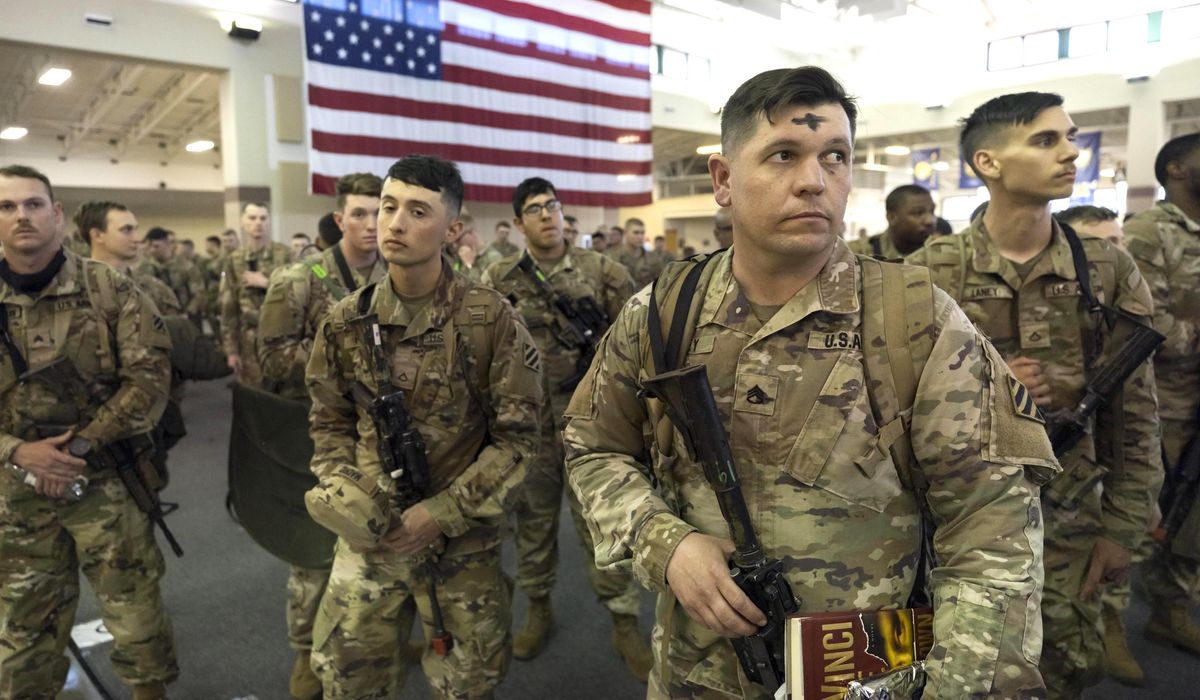

The future of America’s long-term troop presence in Europe came into focus Wednesday as President Biden announced new plans to permanently place fresh U.S. personnel in Poland, air defense batteries in Italy and Germany, and a host of other steps as NATO reinforces its front line as relations deteriorate badly with Russia in the wake of Moscow’s invasion of Ukraine.
The new deployments, unveiled during this week’s high-stakes NATO summit in Madrid, provide some answers to lingering questions about the Pentagon’s plans for its posture in Europe amid a Russia-Ukraine war that appears destined to drag on for months, or perhaps even years. The number of American forces in Europe has ballooned from about 65,000 to over 100,000 in the four months since Russian President Vladimir Putin launched his attack on Ukraine, but military officials have been dogged by questions about how long those forces would remain on the continent and what metrics the Pentagon might use to determine when some could redeploy to other theaters or return home.
Wednesday’s announcement makes clear the U.S. is prepared to enhance its presence in Europe for the foreseeable future — a move that is sure to anger the Kremlin and ratchet up already sky-high tensions between Russia and the West.
“The United States and our allies, we are going to step up — we are stepping up. We’re proving that NATO is more needed now than it ever has been and is as important as it ever has been,” Mr. Biden said Wednesday.
But it also complicates American hopes to broaden NATO’s focus and prepare for conflicts beyond the traditional mission of defending Europe against a Russian invasion. Notably, the NATO countries in their updated strategic doctrine in Madrid singled out a rising China as a “source of systemic competition” to the alliance and its values — a move that was largely overlooked in the focus on Ukraine, Russia and Eastern Europe. It was the first time in NATO’s 75-year history in which the China challenge had even been mentioned.
The most notable move from this week’s summit will come in Poland, where the Pentagon will establish a new permanent headquarters for the Fifth Army Corps. The U.S. also will ramp up its rotational troop deployments in Poland, officials said, while beefing up command-and-control capabilities inside the country that would help coordinate Western defenses in the event of a Russian attack on any eastern European nation.
SEE ALSO: Biden: NATO will defend ‘every inch’ of its territory
Poland has a front seat view of the fighting across the border in Ukraine, and has taken in millions of Ukrainian citizens fleeing the fighting. Warsaw has been among the most vocal NATO states saying the alliance must take a tougher stance against Russian aggression.
The idea of substantial increases in America’s military footprint in Poland has been discussed for years. Under former President Donald Trump, Polish officials tried to woo the American side with the promise of a permanent base dubbed “Fort Trump,” constructed and paid for by the Polish government and staffed by U.S. personnel.
Despite early momentum, that idea never got off the ground and ultimately became the subject of ridicule from critics who said it was just another example of Mr. Trump seeking to promote his own name and brand.
While Fort Trump never became reality, the Biden administration made clear Wednesday that it views Poland as a vital piece of NATO defenses and an ideal candidate to host more U.S. troops.
“Poland is a strong NATO ally. It has made its own decisions on increasing defense spending, on increasing its own combat capability, on modernizing its defense forces. And so, the bilateral partnership that the United States has and the enhanced presence we will now have in Poland supports the broader NATO capabilities,” Assistant Secretary of Defense for International Security Affairs Celeste Wallander told reporters Wednesday.
Indeed, the country has already proven to be an irreplaceable part of both NATO security and Western military assistance to Ukrainian forces on the front lines of battle. Western weapons, vehicles and equipment routinely flow through the country en route to Ukraine.
Public support in Poland for pursuing the complete defeat of the Russian invaders, meanwhile, remains much higher than in many other European countries, recent polling data show.
Beefing up
The U.S. announced a host of other military moves Wednesday. Pentagon officials said they’ll position a fresh rotational brigade combat team in Romania with the ability to “deploy subordinate elements across the eastern flank” of NATO. Officials said the U.S. also will enhance its rotational troop deployments in the Baltic states.
Rotational forces typically remain in a particular country for under a year and are then replaced by other troops, whereas permanent deployments last for several years and often involve the service members’ families moving to Europe along with them.
Defense officials also said the U.S. will increase from four to six the number of Navy destroyers stationed at the Rota Naval Base off the southern coast of Spain. The Pentagon also will establish a new air defense artillery brigade headquarters in Germany, along with a short-range air defense battalion and other assets. About 625 fresh troops will be stationed in the country, officials said.
Another 65 personnel will be sent to Italy as part of a new short-range air defense battery established in that country, officials said.
U.S. and NATO officials say that the deployments are meant as both a deterrent against potential Russian attacks and also as a line of defense in the event of a conflict. While the Biden administration has sought to avoid a direct clash with Moscow, Ukrainian President Volodymyr Zelenskyy — who addressed the NATO summit by video from Kyiv on Wednesday — said Russian assaults beyond Ukraine are a matter of when, not if, for Western nations.
“The question is who’s next? Moldova? Or the Baltics? Or Poland? The answer is: all of them,” he said. “We are deterring Russia to prevent it from destroying us and from destroying you.”
Some specialists argue the U.S. could soon face the prospect of needing to increase its European defense posture even further. They say that when Finland and Sweden join the ranks of NATO — which looks all but certain after Turkey dropped its objections to the move this week — the U.S. could be expected to help guard Finland’s massive border with Russia.
“Those discussions should be had now — to include the true costs of planning for deployment and sustainment — before Finland is accepted into the alliance,” said Mike Sweeney, a fellow with the think tank Defense Priorities, which advocates a more restrained American military role abroad.
“Simply put, U.S. forces cannot be everywhere at once. At some point, choices need to be made,” he wrote in an analysis posted on the organization’s website Wednesday.
Following dramatic early losses for invading Russian forces, the Ukraine struggle has devolved into a grinding ground war centered in Ukraine’s eastern Donbas region, with Russian and pro-Moscow separatist troops making slow but steady progress against determined Ukrainian resistance.
The Associated Press reported Wednesday that Russian forces were battling to surround the Ukrainian military’s last stronghold in a long-contested eastern province, with Ukrainian troops falling back to prevent being surrounded. Russian troops and their separatist allies control 95% of Luhansk and about half of Donetsk, the two provinces that make up the mostly Russian-speaking Donbas.
— This article is based in part on wire-service reports
